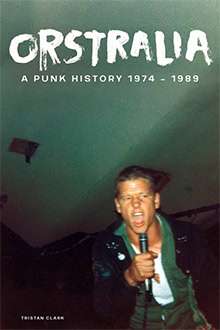
There’s a lot to like about this book – and a few things to not like so much.
Tristan Clark is spot on when he identifies punk less as a musical style and more as an attitude, a rejection of the establishment and a change in approach that turned the music scene on its head across Australia, the US, Europe, and the world.
The freedom to play as fast, as loud, and as badly as anyone ever wanted, straight from a garage to venues small and large, created a musical dynamic that continues to influence bands 50 years later. In the late 20th century, punk’s rudeness and crudeness refreshed and rejuvenated popular music, and Clark nails that.
Clark is also astute in identifying how Australian bands were influenced by different musical styles under the punk umbrella, chief among them the Detroit style of MC5 embodied notably here by Radio Birdman, the New York based sound of the The Ramones, and the UK style of Sex Pistols, The Clash, and the like.
Huge points for mentioning just about every band to which the punk label could be applied in the 25 year period covered, and double points for getting quotes on their history from band members themselves. That’s probably the single best thing about the book – that the musicians paint their own picture. At least, the ones that survived.
Clark was also wise in not limiting his coverage to any imposed definition of punk, identifying how various bands influenced each other and band members cross-fertilised the scene as they shifted from one group to another, creating a web of punk influence across metal, hardcore, thrash, rock, and pop.
The book has a good structure, swinging through Australia’s major cities from 1974-82 and then 1982-89, getting across a real sense of how the country’s geography, economics, and politics led to waves of punk bands with distinct identifiers.
Clark pays close attention to these social factors and how they created groups that identified themselves with punk music, even if the bands themselves didn’t feel part of those groupings. The musical aggression of punk often attracted the physical violence of skinheads, for example, to the detriment of musical performance.
As an account of how a social phenomenon shaped some of Australia’s musical evolution of the period, this book is a cracker.
My quibbles are relatively minor.
There are some terrible typos, probably the worst being the mis-spelling of Bjelke-Petersen as Bjekle-Petersen at least 10 times, although a few other times he got it right. That’s more the editors’ fault, though.
Scant attention is paid to venues, which I found a bit mystifying. Iconic venues like the Sydney Trade Union Club and French’s barely get a mention in passing, while others like the Hopetoun Hotel and the Southern Cross (later Strawberry Hills) don’t rate even that. In my experience, they were key to the growth, exposure, and influence of punk, and their individual characteristics made a big difference.
Clark has a bad habit of using multi-syllable words when simple ones would do much better – and he uses a lot of them incorrectly. I don’t know whether he was aiming at sounding academic and intellectual but it just comes across as pompous and ill-informed.
Some of the descriptions of the scene in Sydney, Newcastle, Wollongong, and Hobart didn’t ring true to my experience, but then maybe what I lived through wasn’t typical.
And, to be fair, what Clark does capture is that there really wasn’t – and isn’t – a typical punk. That was part of the point of punk in the first place.
Overall, Orstralia was a very enjoyable read and comprehensive in its band coverage, brought back some great memories, and gives fair credit to a musical phenomenon that deserves this kind of attention but probably won’t get it elsewhere.
There is a second volume available, Orstralia: A Punk History 1990-1999.